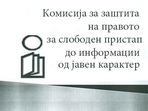ПРОФИЛ
MUNICIPALITY
DEPARTMENTS
БАРАЊА
USEFUL INFO
| The custom „Chetrse“ (Forty) on the list of UNESCO |
|
The national commission of UNESCO marked the introduction of the first good of the Macedonian representative list of intangible world cultural heritage by UNESCO – the ritual “Chetrse” (Forty). The application was submitted in 2011, and the announcing was during the conference in Baku (2nd – 7th of December 2013). This is a unique and centuries-old custom in Shtip, practiced on the religious holiday of St.40 Martyrs on the 22nd of March, when people of all ages climb the fortress Isar, throw small rocks from the top of the fortress, and on the getting down they greet with 40 people. The young collect 40 rocks, they throw 39 in the river of Bregalnica, and leave one rock, because the same night they put it under their pillow and there is a belief saying that they will have a dream of their life partner. The General Secretary of the National Commission of UNESCO Lidija Topuzovska said that Macedonia has numerous non-material cultural goods and that she expects that “Chetrse” (Forty) will open the road for two more applications submitted in 2011 – the male folk dance “Kopachka” from Dramche, Delchevo, and also the two voices singing of males “Glasoechko” which applies for the current list – for emergency aid of goods which are in danger of extinction. - The non-material cultural heritage in Macedonia is cherished for centuries and it is passed down the generations. It is a milieu of rich source of various forms of expression and exercise of intangible cultural heritage. This is a great honor, a privilege, but also it is an obligation for us to find ourselves on the list of UNESCO as a masterpiece and a universal value that now, after the entrance, officially becomes a world non-material cultural heritage – said Topuzovska. The certificate of inscription of “Chetrse”(Forty) signed by the general director of UNESCO Irina Bokova who handed it to the Mayor of Shtip Ilcho Zahariev, who said that Shtip is a city with a history and a fantastic culture, a city of Christianity, youth and beauty, a birthplace of significant persons, so it is no coincidence that it is the first precisely inscribed Macedonain cultural good on the list of the world organization. The application was developed in collaboration with the Municipality of Shtip and by the Institute of folklore “Marko Cepenkov”, whose director, ethnologist Zorancho Malinov, said he was proud of being a citizen of Shtip because he also practiced the custom and because the first good from Macedonia is protected with him being a director. Ivona Opetchevska-Tatarchevska and Velika Stojkova-Serafimovska shared their impressions of the declaration in Baku, informed us about the complex application process which understands scientific documentation and archiving, filing forms with strict specific issues and criteria that are stricter every year. - The meaning of these goods is enormous, although not able to be seen. They last from the time when cultural identities started to create. The inscription of “Chetrse” (Forty) is a historical act that UNESCO recognizes the Macedonian culture and identity, which is especially important to these times. This brings many benefits to being able for Shtip to become a brand – said Stojkova Serafimovska a researcher at the Institute of Folklore. UNESCO Convention for protection, recognition and promotion of the non-material cultural heritage was adopted in 2003, and Macedonia is among the 30 countries that have ratified it first. Currently there are 157 countries-members.
|
Latest articles
- Работна средба за зголемување на соработката помеѓу локалните чинители и општината за поголема финансиска транспарентност
- Донесена одлука од областа на социјалната, детската и здравствената заштита
- Посета на Државното првенство во борење за возрасна категорија У23 за 2022 година
- Обновени зелените насади на првиот опфат од конзолата на улица „Васил Главинов“
- Средба со младите фудбалери на Академијата Постолов - Пандев


















